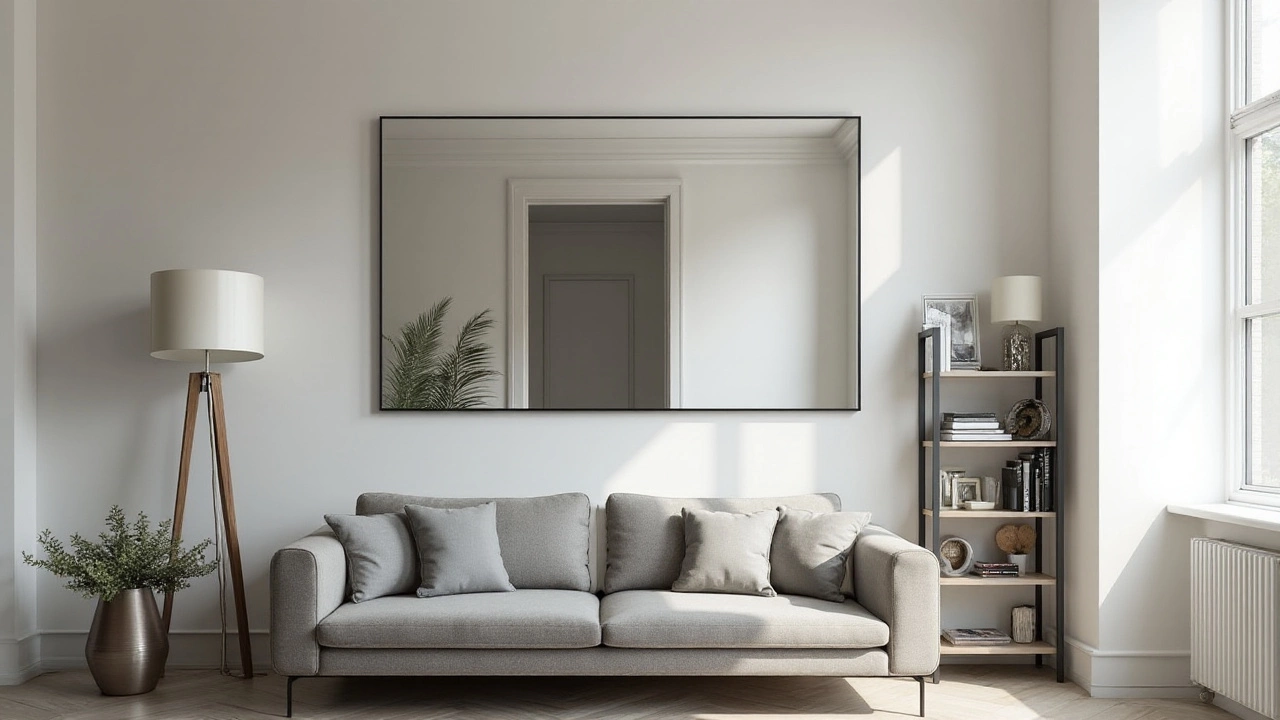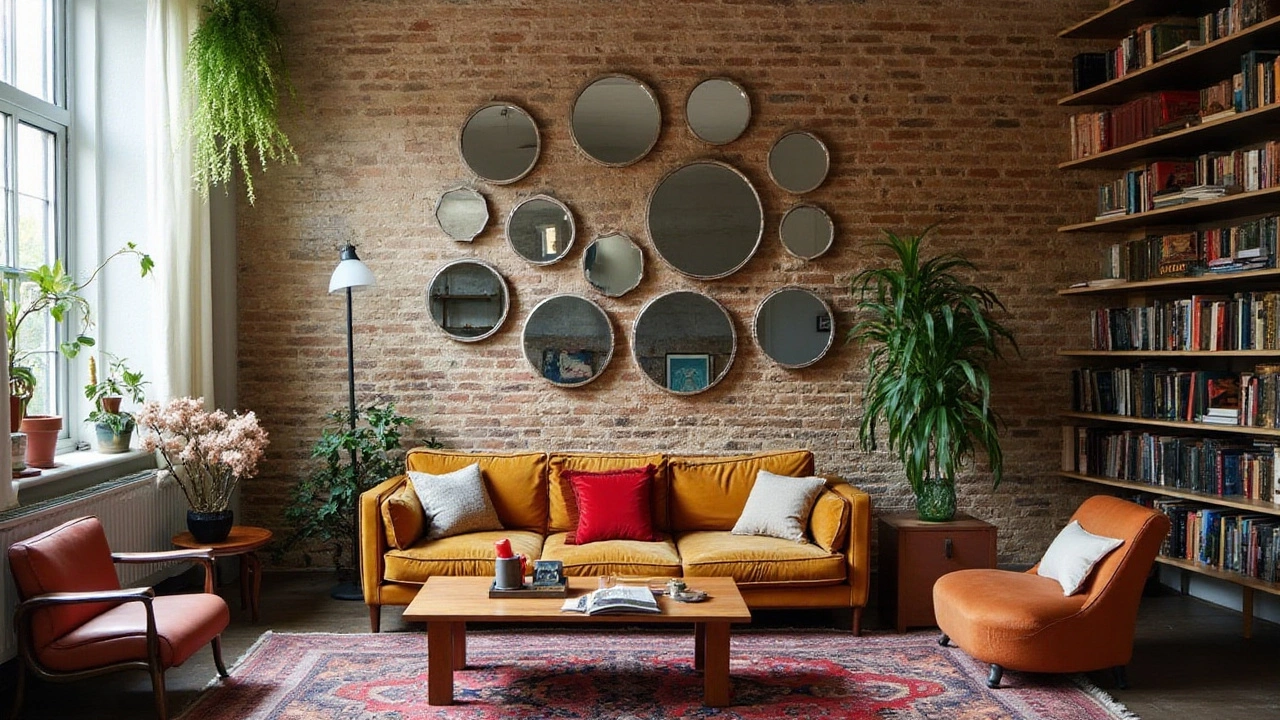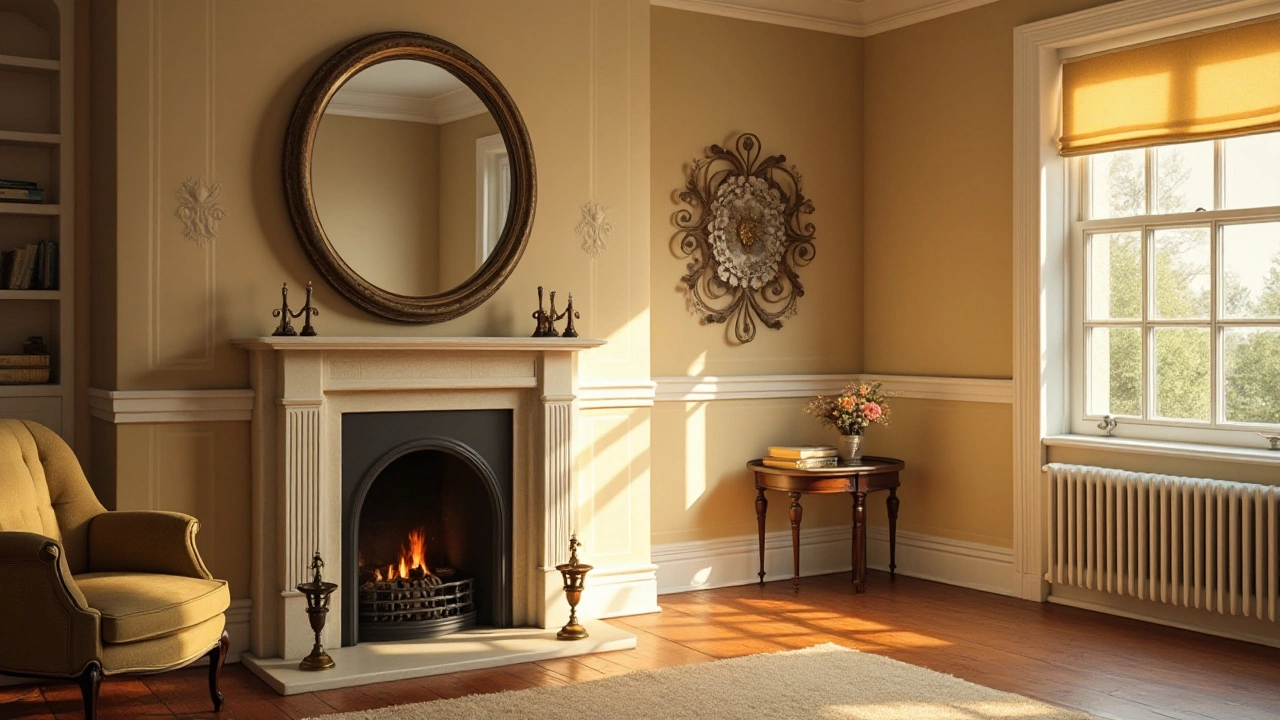Mirrors aren't just for checking your reflection; they are a secret weapon in the world of interior design, especially when it comes to altering how big a room feels. The shape of a mirror plays a crucial role in determining how it impacts the sense of space in a room. A well-chosen mirror can reflect light and create illusions of depth, making even the tiniest of rooms appear larger.
In this exploration of mirror shapes, we'll dive into how different forms like round and rectangular mirrors contribute to a room's aesthetic and sense of space. Whether you have a studio apartment or a cozy living room, understanding these principles can help you make the best choice when investing in your next mirror. Beyond the basic shapes, creative and fun mirrors can add a touch of personality and transform your environment. Dive into the possibilities and discover which styles might best serve your space-enhancing goals.
- The Illusion of Space: How Mirrors Work
- Round Mirrors: Soft Curves and Spacious Vibes
- Rectangular Mirrors: Extend and Elongate
- Unexpected Shapes: Creative Reflections
- Placement Tips: Where to Hang Your Mirror
The Illusion of Space: How Mirrors Work
Mirrors have long fascinated humans with their ability to reflect not only our images but also the environment around us. This reflective quality is precisely what makes them such powerful tools in interior design, transforming the ambiance and perceived size of a room. Mirrors work their magic through the principle of reflection, allowing them to bounce light around a space, which in turn can trick our eyes into feeling like a room is larger and more open than it actually is.
When strategically placed, mirrors capture and amplify both natural and artificial light. This is particularly effective in rooms that may lack windows or feel a bit confined. By reflecting light back into the room, mirrors can brighten spaces, lending an airy and expansive feel to even the smallest of nooks. This enhanced brightness creates a visual trickery, convincing the observer that there's more space than there actually is. Choose the right mirror, and it's like adding a window where none exists.
History shows us that mirrors have been used for interior enhancement for centuries, dating back to the ornate mirror designs of Renaissance Europe. These historical examples showcase their timeless appeal and enduring functionality. Today, mirrors continue to be a staple in home decor, hailed by designers for their versatility in manipulating the perception of space. A well-placed mirror can anchor a room, providing a focal point that distracts from the room's actual dimensions.
"The mirror is a deep lake. The lake is a shining mirror." – Sylvia Plath
An interesting aspect of mirrors is how they can be used to echo the pattern and rhythm of a room's furnishings. This visual repetition furthers the illusion of space, as the eye is drawn across mirrored surfaces that mimic the real objects they reflect. For instance, a rectangular mirror placed horizontally along a wall of bookshelves can suggest the continuation of that wall, enhancing the sense of depth and dimension. It's a subtle art that plays with viewer perception, creating an orchestrated dance between reality and illusion.
Let’s consider the impact of shapes. A rounded mirror can introduce a sense of movement and softness, breaking up the hard lines of rectangular rooms. By contrast, a larger rectangular mirror can extend the sightline, making walls feel like they stretch endlessly. Both shapes utilize the reflective power in unique ways to influence how we perceive distance and boundary within a room. This nuanced use of shape is key to utilizing mirrors' full potential in space enhancement strategies.
For those looking to maximize their living spaces, understanding how mirror shapes play their part is essential. As more people embark on minimalist journeys, the mirror stands firm as a champion of space optimization. It's amazing to think that an item so simple can wield the might to reshape rooms, proving that in the world of design, sometimes seeing truly is believing.
Round Mirrors: Soft Curves and Spacious Vibes
Round mirrors have an extraordinary ability to reshape the dynamics of a room, offering a unique mix of elegance and functionality. Their soft curves add a touch of fluidity and movement to static walls, making them ideal for spaces that could use more visual interest and balance. These mirrors work well in breaking up the boxy feel of square or rectangular rooms, introducing a more harmonious atmosphere. By their very nature, round mirrors don't have corners, which softens the reflection and creates an illusion of enlarged space, making rooms feel more open and relaxing. This quality makes them excellent choices for entryways, bathrooms, and even living areas, where space might be at a premium but impact shouldn't be compromised.
One of the interesting facts about round mirrors is their ability to act almost as a focal point or piece of art in living spaces. They reflect light evenly, dispersing it more widely than angular shapes, which can create interesting lighting effects as the day progresses. Designers often recommend placing a round mirror across from a window or light source to maximize the natural light bounce, thus accentuating the perceived spaciousness. According to renowned interior designer Kelly Hoppen, "Mirrors are fantastic tools to add depth and enhance a room's charm. They reflect views and add sparkle to any area, often multiplying by two what is effectively only present once."
"The round mirror is a true testament to the idea that less is more—its simplicity quietly commands attention while adding softness to a room's sharp angles." — Architectural Digest
Round mirrors work perfectly when paired with other home decor elements that emphasize circular patterns, such as cushions, rugs, or even furniture shapes. This repetition of curves can create a cohesive look, drawing the eye continuously around the room and avoiding visual disruption, which inherently adds to a space's perceived size. Another design trick involves using multiple round mirrors of different diameters on a single wall to create an art installation effect, which not only serves as an interesting visual piece but also enhances the room's dimensionality without clutter.
When deciding on the right size of a round mirror, it's important to consider the wall's dimensions and the existing decor. Large round mirrors are perfect over mantels or sofas, offering a dramatic and elegant look. Smaller ones can be grouped or situated above smaller items of furniture, such as console tables, to create a sense of balance. Meanwhile, the frames play an essential role in determining the mirror's impact. Thick or ornate frames provide a bold statement, while slim, minimal borders can seamlessly integrate with the room's existing palette and decor style.

Rectangular Mirrors: Extend and Elongate
Rectangular mirrors are truly a staple in the realm of interior design when it comes to optimizing space. Historically, rectangular mirrors have been used not only for their reflective qualities but also for their ability to mimic the look of windows; they seem to beam light across a room, tricking the eye into perceiving added depth. This shape offers a timeless aesthetic which effortlessly melds with both contemporary and traditional decor styles. Their linear shape helps draw the eye along horizontal or vertical lines, elongating the visual dimensions of any room. Whether you hang one horizontally across a narrow hallway or place it vertically in a compact bathroom, it opens up spaces in a unique, impactful way.
The placement of a rectangular mirror can maximize natural or artificial light, drastically influencing a room’s atmosphere. Strategically positioning the mirror adjacent to a light source can double the illumination factor, making corners appear brighter and more inviting. Additionally, they serve dual purposes in function and decoration, providing utility while also acting as an art piece. Interestingly, the reflective aspect can capture an environment’s various elements and lend them a seamless backdrop to play against. This versatility may contribute to why they are a favorite amongst interior designers looking to extend a room’s perceived boundaries.
According to renowned interior designer Kelly Hoppen, "Mirrors are like a design necessity. A big mirror adds depth, and when it’s rectangular, you’re effectively expanding your walls."Incorporating a rectangular mirror near furniture like the dining table or a shelf packed with potted plants can add layers of dimension, reflecting a mini landscape into your interior. Designers love using mirrors to create miracles in smaller urban properties where every inch needs maximization. Numerous layouts can benefit from this, especially long and narrow floor plans, which can feel repressive without the vertical or horizontal push a rectangular mirror can provide.
Rectangular mirrors can also be a part of creative arrangements. Grouping them artistically with varied sizes and frames brings a playful yet refined atmosphere to any living space. They work well in almost any room and setup, adding an easy sophistication. Always consider your choice of frame; minimalist designs make the space feel airy, while ornate outlines add bold character. Opt for colours and textures of frames that align with your existing decor, ensuring that your mirror contributes as a harmonious element rather than a discordant one.
Studies show that rooms curated with mirrors tend to have a more alluring aura, encouraging a positive environment. Often, a simply placed rectangular mirror can transform a home’s energy, aligning with Feng Shui principles by redirecting positive chi and creating harmony in the space.
Effective Placement Strategies
One popular strategy is to mount them opposite exits to make guests feel welcome upon entry, capturing and enhancing surrounding beauty. Take care with positioning in bedrooms, though, where mirrors can potentially disturb peace if reflecting beds directly.Unexpected Shapes: Creative Reflections
When it comes to elevating the interior of a room, unexpected mirror shapes can provide a delightful twist. Unlike traditional rectangular or circular options, mirrors that come in abstract or geometric forms offer more than just utility. They bring a piece of art into your living space, serving as conversation starters while creating the illusion of depth in a unique way. Funky shapes can break up the angles of a room, adding dynamism and movement where it might otherwise be lacking. This can be particularly impactful in minimalistic or modern settings, where every element is deliberately chosen for its ability to contribute to the atmosphere.
Designers have long embraced whimsical mirrors for the versatility they bring. Imagine a mirror shaped like the sun with ray-like spires reaching out, or interlocking multi-faceted pieces that reflect light as if a crystal chandelier were embedded in your wall. These mirrors catch the eye and keep it moving, an essential feature that helps spaces feel less confined. When matched with the room's existing decor, they can tie in patterns and shapes, amplifying an aesthetic unity throughout. According to interior designer Nathan Turner, "Creative mirror shapes are not merely reflections of our environment—they reflect our personalities and brighten our spirits."
The key to integrating creative shapes lies in balance. While it's tempting to go all out, you should consider the existing elements in the room. Do they complement the shape of the mirror, or is there tension that might make the addition jarring? Designers suggest that irregular mirrors work best against simple, uncluttered walls. The clear backdrop gives space to the unusual silhouette without overwhelming the senses. The choice of material also plays a crucial role—mirrors framed with metals or woods need to resonate with the room's colors and textures.
Among the unexpected shapes gaining popularity recently, the asymmetrical irregular mirrors offer distinct energy. They give off an artisanal vibe, showing off hand-made craftwork that can subtly enhance spaces filled with personalized, considered furnishings. In contrast, polygonal mirrors add a futuristic flair. They work particularly well in lofts or homes that feature industrial elements like exposed brick or steel tubing.
Interestingly, several studies have suggested that unusual shapes in room decor, including mirrors, can influence cognitive responses by adding a layer of complexity and mental engagement. This explains why we feel drawn to them—they challenge our brains to process their form, stimulating visual interest and intellectual curiosity. Knowing where and how to position these mirrors can further influence how open a room feels. Angling them to capture and reflect natural or artificial light can dramatically enhance the perceived spaciousness. Where you want to direct the eye will dictate the alignment—one that, when done right, can impressively extend horizons without any physical changes to the room.

Placement Tips: Where to Hang Your Mirror
Placing a mirror in your home isn't just about putting it wherever there's wall space. Strategic placement can enhance its impact, making a room feel more open and welcoming. One fundamental tip is to consider what's opposite the mirror. Is it a window? That's great! A mirror opposite a window can reflect natural light, brightening up a room and making it feel larger. If it's not a window, how about an open space or a piece of art? This reflection can create a sense of balance and wideness that opens up the room.
Height is another critical factor. For optimal viewing, the center of your mirror should generally be at eye level, about 57-65 inches from the floor. However, if you’re using mirrors for an illusion of spaciousness above a fireplace, higher placement can draw the eye upwards and create a feeling of airiness in the space. Additionally, when hanging mirrors in a dining room, consider placing them so they reflect the dining table. This trick makes the room appear as though it continues forever, a clever method to add the illusion of depth.
Rectangular mirrors above couches or beds can elongate a room, while round mirrors add softer, more relaxed vibes. Still, these rules aren't set in stone. Sometimes breaking them with a unique mirror shape can be the breath of fresh air that your room needs. One creative tip is to group smaller mirrors together to cover a larger area of a wall. This can create an artistic focal point while still providing the benefits of a mirror's expansive effects.
According to interior designer Nate Berkus, "Every room needs a good reflective surface. Mirrors are like a room's best friend."
Nate's insight underscores just how vital placement is. By thinking about a mirror's relationship to the surrounding furniture and lighting, you can maximize the benefits. Don't shy away from experimenting with different orientations to see how they change your space. It’s these dynamic arrangements that can truly optimize your room's layout.
If you're feeling bold, floor-to-ceiling mirrors are an option to make small spaces appear cavernous. However, for those worried about floor space, even a small mirror added in unexpected places, like the back of a door, can make a difference. Don't underestimate the effect of mirrors in narrow hallways; they can instantly convert an otherwise tight path into a seemingly broader gallery. Consider testing various spots with a handheld mirror first—this simple step can be enlightening in deciding if a spot will work or if you need to rethink your strategy. A little trial and error will guide you toward an intriguing setup that maximizes your home's aesthetics and spaciousness.

